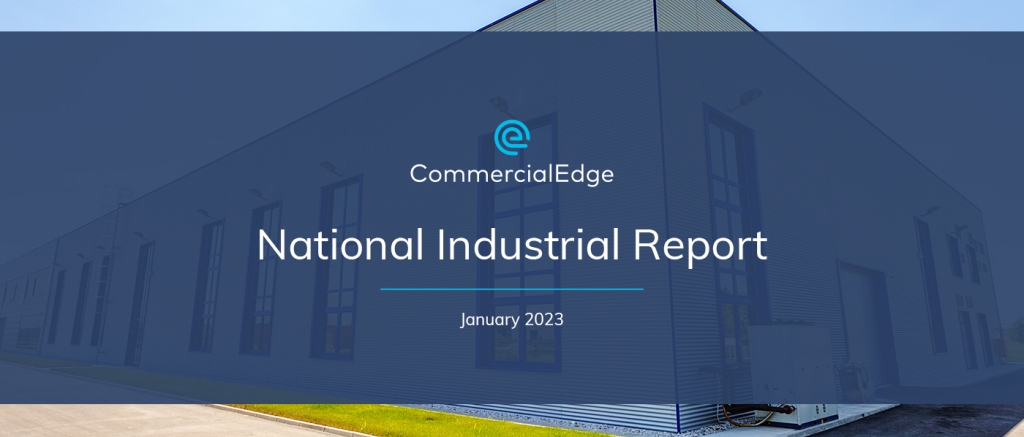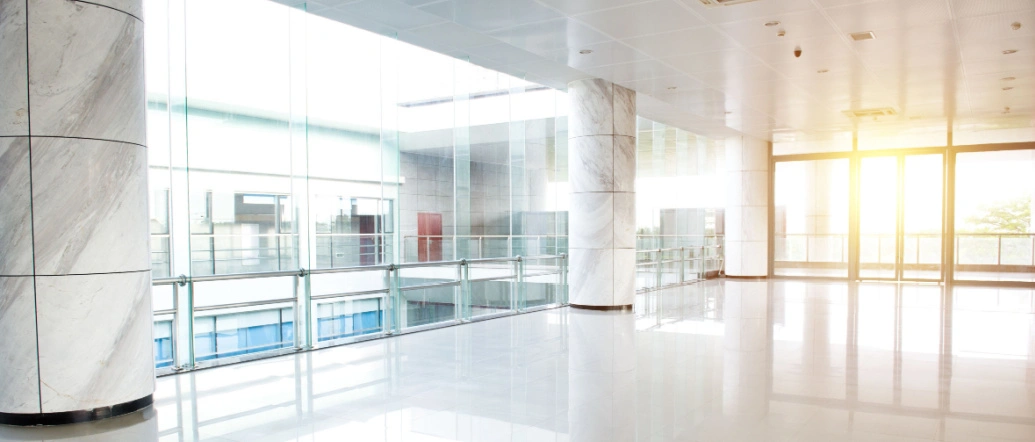
2022 Sets Industry Record with 450 Million Square Feet of Deliveries

Key Takeaways:
- National industrial in-place rents averaged $7.03 per square foot, up 6.3% year-over-year as demand continued to outpace supply
- The national vacancy rate contracted 180 basis points in 2022 as new deliveries were absorbed at a rapid pace
- More than 450 million square feet of industrial space was delivered last year, setting a new industry record
- The year ended with $88 billion in industrial sales, a robust volume but one that was noticeably below 2021 totals
- Western markets posted the six highest sale prices nationwide, with Orange County closing 2022 at $369 per square foot
- Columbus tied with Nashville for second-lowest vacancy rate nationwide at just 1.8%, and Indianapolis close behind at 2.3%
- Dallas led the nation in development with 64 million square-foot pipeline as well as sales with $8.8 billion volume
- At $3.53 per square foot, New Jersey lease premiums ranked among the five highest in the country
New industrial supply hit record levels in 2022, and 2023 is expected to reach yet another generous volume of new deliveries. In the 118 markets covered by CommercialEdge, more than 450 million square feet were delivered last year, with another 713 million square feet under construction at the end of the year, according to the latest U.S. industrial market report.
“Even as demand waned slightly the last third of the year, the appetite for these new, high-quality facilities was incredibly strong throughout 2022.”
Peter Kolaczynski, CommercialEdge Senior Manager
Despite historic levels of new supply, this pace of development was not enough to keep up with demand. Thus, the average vacancy rate for the top 30 markets fell steadily throughout the year, closing 2022 at 3.9%. Our industrial property outlook predicts that due to a cooling economy and healing supply chains, absorption will be positive this year, but lower than in previous years.
Nonetheless, demand for industrial space will remain substantial across the U.S., driven by high import levels, e-commerce and the need for last-mile facilities. In light of this, developers will continue to expand the national industrial stock — over the next five years, the U.S. industrial footprint could increase by roughly 12.6%, according to CommercialEdge supply forecasts.
Construction: Completed & Forecasted
Rents and Occupancy: Southern California Drives Largest Gains in Leases
National in-place rents for industrial space averaged $7.03 per square foot in December, growing 6.3% year-over-year and three cents over the previous month. Leases signed in the last 12 months reached a national average of $8.84 per square foot, $1.81 more than in-place contracts.
The largest spreads between new leases and the market average were in Los Angeles ($7.24), the Inland Empire ($5.66), Orange County ($4.96), Nashville ($3.75) and New Jersey ($3.53), trends that were mostly steady throughout the year.
Average Rent by Metro
Up 10 basis points from November, the national industrial vacancy rate stood at 3.9% in December, dropping 180 basis points over the last 12 months. The lowest vacancy rates in the nation were in the Inland Empire (1.1%), Nashville (1.8%), Columbus (1.8%), Indianapolis (2.3%) and Los Angeles (2.4%), markets that contended with low vacancies throughout the year.
In order to ease that pressure, many of these low-vacancy markets have robust development pipelines, such as the 31 million square feet under construction in the Inland Empire and the nearly 18 million square feet Indianapolis is currently developing.
Supply: Record 450 Million Square Feet of New Supply Delivered in 2022
Nationally, 713.0 million square feet of industrial stock were under construction at the end of 2022, representing 4.0% of stock. An additional 698.4 million square feet were in the planning stages.
Last year saw more than 450 million square feet of industrial supply delivered, a record for new development. The markets with the most supply delivered last year were Dallas (31.5 million square feet), Indianapolis (24.8 million), Chicago (23.4 million), Phoenix (21.3 million) and the Inland Empire (20.4 million). While industrial development was and remains widespread across the country, those top five markets accounted for 27% of all new stock in 2022.
Industrial Space Under Construction (Million Sq. Ft)
In 2022, 25 of the 118 markets covered by CommercialEdge had their highest levels of new development since at least the turn of the century. Indianapolis, Phoenix, Savannah-Hilton Head (14.6 million square feet), Kansas City (11.7 million), New Jersey (11.1 million) and Austin (10.4 million) were among the markets that saw record levels of new industrial stock delivered in 2022. With more new supply than ever currently under construction, 2023 is expected to be another record-setting year for industrial deliveries.
Transactions: Deal Flow Slows in Second Half of 2022
There were $88.3 billion in industrial transactions during 2022, although a certain lag in collecting sales data means that 2022 numbers will continue to climb. One thing is undeniable, however: Last year is certain to come in under the $125.7 billion in 2021.
Year-over-year sales were up in the first half of last year but fell quickly in response to rate increases by the Federal Reserve. Rising interest rates were the main reason why the national sales volume fell in the second half of 2022, but the fact that industrial properties are much more expensive than they were even a few years ago is also a factor. The average sale price of an industrial building has skyrocketed, from $83 per square foot in 2019 to $132 in 2022, representing an increase of 57%.
Year-to-Date Sales (Millions)
Even as rents have increased rapidly, investor appetite for industrial has pushed prices high enough to diminish opportunities for yield. Investors may now need to assume current rent growth will continue for the foreseeable future in order for deals to pencil out, given current prices and borrowing costs.
Under these circumstances, transaction volumes are likely to continue to slow in 2023, although once the Fed pauses interest rate hikes it may provide enough stability to the market for deal flow to pick up steam again. With demand for industrial space still elevated and supply still playing catch-up, prices are not expected to fall much, if at all, in 2023.
Western Markets: Phoenix Construction Pipeline Reaches 55 Million Sq. Ft. With Planned Projects Potentially Doubling That Volume
The Inland Empire led the country in industrial rent growth, with rates increasing 14.2% over the last 12 months. Although backlogs that were plaguing the ports of Los Angeles and Long Beach eased during 2022, demand for space in Southern California continued to be hot and vacancy rates remained tight. Los Angeles was the second-fastest market for rent growth at 10.4%, and Orange County was fourth with 7.3% growth in the last 12 months.
The demand for industrial space in Southern California has been so intense that there has been a spillover into Phoenix, a six-hour drive from the ports of Los Angeles and Long Beach. In Phoenix, rents have grown 7.1% over the last 12 months despite 21.3 million square feet being delivered in 2022.
To further absorb spillover demand from Southern California, Phoenix has an astounding 55 million square feet of new supply underway which will increase the existing local stock by 18.3%. That is by far the largest supply pipeline on a percentage-of-stock basis in the country, with the next-closest being the Dallas-Fort Worth market at 7.5%. And the Phoenix industrial boom is far from slowing down, as planned projects would further increase the local stock by 20.8%.
West Regional Highlights
While many companies are reorienting to Phoenix for their industrial space needs, Southern California is also pushing ahead with development where space availability allows. Los Angeles and Orange County struggle with space constraints, evident in their respective construction pipelines: 3.3 million square feet in Los Angeles and 1.2 million in Orange County. But the Inland Empire has the third largest development pipeline in the country, with 31 million square feet under construction at the end of 2022, with nearly the same amount currently in the planning stage.
Although its sales volume was a far more modest $1.15 billion, Orange County boasted the highest sale price nationally by a wide margin, averaging $369 per square foot. In fact, the six highest sale prices were all claimed by Western markets: The Inland Empire featured the second-highest sale price nationally at $289 per square foot, with Los Angeles close behind at $287 per square foot. They were followed by Seattle’s $246 per square foot rate, the Bay Area’s $232 per square foot average and Phoenix at $198 per square foot.
Returning to Southern California, Los Angeles and Orange County also had the second- and third-largest sales volumes in 2022, outpaced only by Dallas’ $8.78 billion total. Specifically, Los Angeles totaled $5.1 billion in industrial sales last year, followed closely by the Inland Empire’s $4.99 billion.
On the other end of the spectrum stood Central Valley with only $640 million in industrial deals, the second-lowest volume among the country’s leading markets. It also had the lowest sale price among the West’s top markets, averaging $92 per square foot in 2022.
Midwestern Markets: Columbus and Indianapolis Post Two of the Three Lowest Vacancy Rates Nationwide
While the Inland Empire remained the uncontested leader in occupancy, closing 2022 with a vacancy rate of just 1.1%, Midwest markets also stood out. Specifically, Columbus tied with Nashville for the second-lowest vacancy rate in the country at just 1.8%, followed by Indianapolis at 2.3%, outpacing Los Angeles and its 2.4% rate.
But while Southern California rents remain the highest in the country by wide margins, Midwestern markets, including its tightest, continued to post some of the most affordable rents among the country’s top markets. Columbus, for example, had the lowest lease rate at just $4.14 per square foot, Indianapolis had the second lowest at $4.29 per square foot, with St. Louis and its $4.32 per square foot rate next.
Midwestern markets also closed 2022 with some of the lowest sale prices the country’s most important industrial markets, remaining — as they have been throughout the year — among the more affordable markets for commercial real estate players looking to enter the industrial sector with lower stakes investments.
Midwest Regional Highlights
For example, Kansas City posted the lowest sale price among leading markets at just $53 per square foot which also resulted in the smallest sales volume: $631 million in total. Detroit and Columbus were next at $76 per square foot and $78 per square foot respectively. In fact, the Twin Cities market was the only one to surpass $100, closing the year at an average sale price of $102 per square foot.
Consequently, Midwestern markets also had more modest sales volumes, ranging between $1.04 billion and $1.37 billion, with two notable exceptions: Chicago and Kansas City. The latter had the lowest sales volume among the country’s top industrial markets, having totaled just $631 million in industrial deals in 2022. Chicago, however, had the fourth-highest sales volume nationwide: It closed $1.16 billion in industrial deals, despite a sale price of just $87 per square foot.
One major factor in keeping industrial leases far more affordable than those in comparably tight markets was the region’s robust construction pipeline. Chicago closed 2022 with the fourth-largest development pipeline in the country at 28 million square feet. That represented 2.8% of Chicago’s existing stock, while planned projects could add the equivalent of 3.5%.
When looking at development pipelines from the perspective of percentage-of-stock, Columbus and Indianapolis stood out as two of the five leading markets. Specifically, Columbus had the equivalent of 5.8% of its stock under construction at the end of 2022, while Indianapolis was developing 5.3%.
Southern Markets: Dallas Leads the Nation in Development, Sales Volume
Nashville remained the leading Southern industrial market in terms of occupancy rate, with only 1.8% of available space across the market. It was followed by Miami at 3.0%, Atlanta and Charlotte at 3.3%, and Dallas – Fort Worth at 3.8% — the only markets with industrial vacancy rates below the 3.9% national average. In contrast, Houston had the highest industrial vacancy rate at 7.7% both in the South and nationwide.
At the same time, markets with higher vacancies also saw more modest rent increases. For instance, Houston saw lease rates increase 2.1% year-over-year in December, while Memphis and Tampa rents gained 2.6% and 2.9%, respectively. Atlanta led rent growth in the region at 6.9%, becoming the only Southern market that outpaced the national growth rate of 6.3%. Baltimore, for example, was up 5.6% and Nashville lease rates appreciated 5%.
Although Southern markets had more modest lease spreads, Nashville stood out: While in-place rents averaged $5.23 per square foot here, new leases signed over the past 12 months averaged $8.98. Similarly, Miami’s in-place rents stood at an average of $9.72 per square foot, whereas new contracts signed at $13.05 per square foot.
South Regional Highlights
The Dallas – Fort Worth Metroplex led construction in the South, as well as the nation, with 64.2 million square feet of industrial space under construction as of December, accounting for 7.5% of total stock. Considering projects in the planning phases as well, the Metroplex’s industrial stock could increase by as much as 13.5%.
The Dallas – Fort Worth industrial market also attracted the most capital in 2022 nationwide, recording $8.78 billion in sales, at an average price per square foot of $180. Despite its sluggish fundamentals, Houston had the second-largest sales volume in the South and the fifth-largest across the U.S., with more than $4 billion in industrial deals. When it came to pricing, industrial facilities traded at an average of $131 per square foot in Houston, in line with the $132 national rate.
Northeastern Markets: Imports Expected to Keep Demand High for New Jersey Industrial Space
New Jersey continued as one of the strongest industrial markets in the nation, with its vacancy rate resting at 2.6% at the end of 2022, slightly above the 2.4% recorded in Los Angeles but below Orange County’s 3.0% rate. New Jersey also saw a robust uptick in industrial rents in the 12 months ending in December, climbing 8.4%. This is above the 6.3% year-over-year national growth and the third highest in the country. Rent growth in New Jersey is expected to continue, as new lease premiums reached $3.53 per square foot — the fifth widest lease spread in the U.S.
Boston and Philadelphia registered rent increases more in line with the national average, up 6.5% and 6.0% year-over-year in December. Rates for new leases were also higher than in-place rents in both markets, with a spread of $1.68 per square foot in Boston and $1.48 in Philadelphia.
Northeast Regional Highlights
Across leading northeastern industrial markets, investors closed roughly $8.28 billion in transactions over the course of 2022. New Jersey topped the list with $3.42 billion in sales, at a price per square foot of $182 — also the highest in the region. Comparatively, Boston totaled merely $1.78 billion in sales over the same period, although its average price of $180 per square foot was close to that of New Jersey.
Philadelphia led the Northeast in terms of new supply, with nearly 20 million square feet of industrial space in the pipeline, representing 4.9% of total stock. Meanwhile, Boston had 6.5 million square feet, or 2.9% of its stock underway, and New Jersey had 12.4 million square feet, or 2.3% of the local stock under development.
Economic Indicators: Producer Prices Cool in December
Wholesale prices for goods and services fell in December, according to the Bureau of Labor Statistics. The headline Producer Price Index — which measures the prices paid by business — fell by 0.5% in December and finished 2022 up 6.2% on the year.
The decline in December was the biggest drop in the PPI since April 2020. The goods component of the index fell 1.6% in the month (up 7.9% year-over-year) and service increased 0.1% (up 5.0% year-over-year). Much of the decline was driven by decreases in energy prices. Core PPI, which excludes food and energy, increased by 0.1% in the month (5.5% year-over-year).
Producer Price Index
The Fed’s interest rate hikes have been aggressive in an attempt to bring down inflation, and the latest readings of the PPI and Consumer Price Index indicate that the rate increases may be working. Price pressures such as supply chain backlogs have eased, and the outlook for inflation in 2023, while higher than averages seen in recent decades, looks to be much tamer than in 2022.
Trends & Industry News: Industrial Market Outlook Solid for 2023
Industrial went through a massive shift in recent years: Demand skyrocketed, vacancies plummeted, and investors drove up average sale prices by more than 50% in three years. But 2023 may be when things finally normalize. The CommercialEdge industrial property market report predicts that the sector will cool somewhat but continue to expand and remain one of the more attractive asset classes in commercial real estate.
Rising interest rates and a looming recession will slow leasing activity as businesses pause expansion plans and grapple with a higher cost of borrowing. Supply-chain normalization will lead to less need for increased inventories than was common in recent years, further slowing leasing.
Still, import flow will continue to drive demand in already tight port markets, and we anticipate the overcrowding of Southern California ports and increased demand for industrial space along the East Coast in markets like New Jersey, Houston and Savannah-Hilton Head. Interest rate hikes will also continue to put downward pressure on transaction volume.
Economic Indicators
E-commerce will continue to create industrial demand in 2023, albeit at lower levels than seen during previous years. Online purchases will continue to grow their share of retail sales, and big-box retailers will continue to embrace digital and omnichannel sales.
Amazon’s 2022 pullback will not be reversed this year, and consequently, there will be less demand for multimillion-square-foot distribution centers this year than during the first two years of the pandemic. However, our industrial market outlook reveals that demand for last-mile distribution facilities will grow, especially for well-located facilities in high-growth markets.
Download the complete January 2023 report for a full picture of how U.S. industrial markets fared throughout 2022, including insights on industry and economic recovery fundamentals.

You can also see our previous industrial reports.
Methodology
The monthly CommercialEdge national industrial real estate report considers data recorded throughout the course of 12 months and tracks top U.S. industrial markets with a focus on average rents; vacancies (including subleases but excluding owner-occupied properties); deals closed; pipeline yield; forecasts; and the economic indicators most relevant to the performance of the industrial sector.
CommercialEdge collects listing rate and occupancy data using proprietary methods.
- Average Rents —Provided by Yardi Market Expert, a cutting-edge service that uses anonymized and aggregated data from other Yardi platforms to provide the most accurate rental and expense information available.
- Vacancy — The total square feet vacant in a market, including subleases, divided by the total square feet of office space in that market. Owner-occupied buildings are not included in vacancy calculations.
Stage of the supply pipeline:
- Planned — Buildings that are currently in the process of acquiring zoning approval and permits but have not yet begun construction.
- Under Construction — Buildings for which construction and excavation has begun.
Sales volume and price-per-square-foot calculations for portfolio transactions or those with unpublished dollar values are estimated using sales comps based on similar sales in the market and submarket, use type, location and asset ratings, sale date and property size.
More Articles You Might Like
Walkable Urbanism to Drive Future Real Estate Development in the U.S.
The 2023 Foot Traffic Ahead report takes an in-depth look at walkable urban areas in the top 35 U.S. metros.
Global Medical REIT Streamlines Deal Flow and Portfolio-Wide Reporting with Deal Manager
With Deal Manager, Global Medical REIT streamlines portfolio-wide reporting and access to fast and accurate leasing data across teams.



